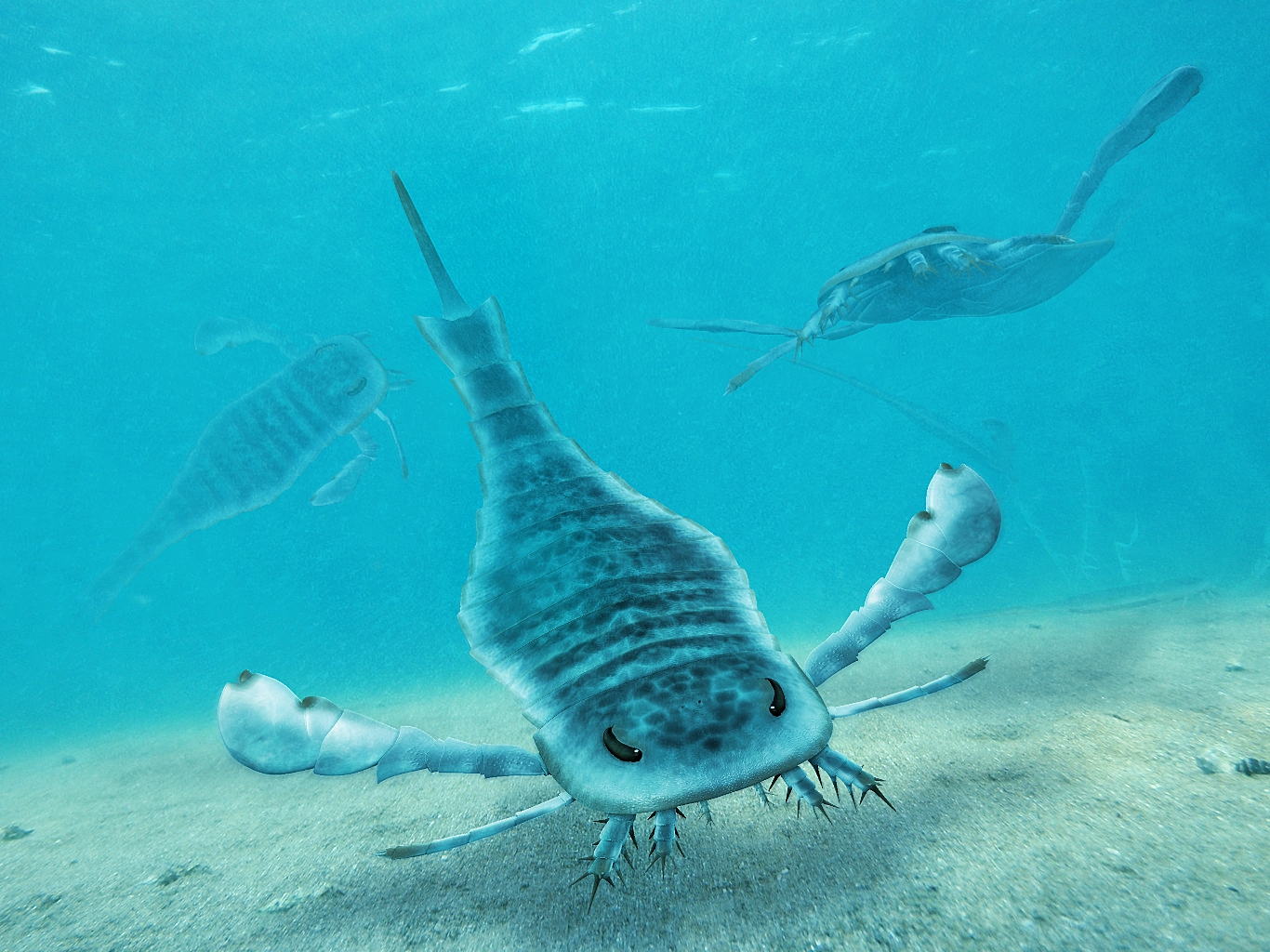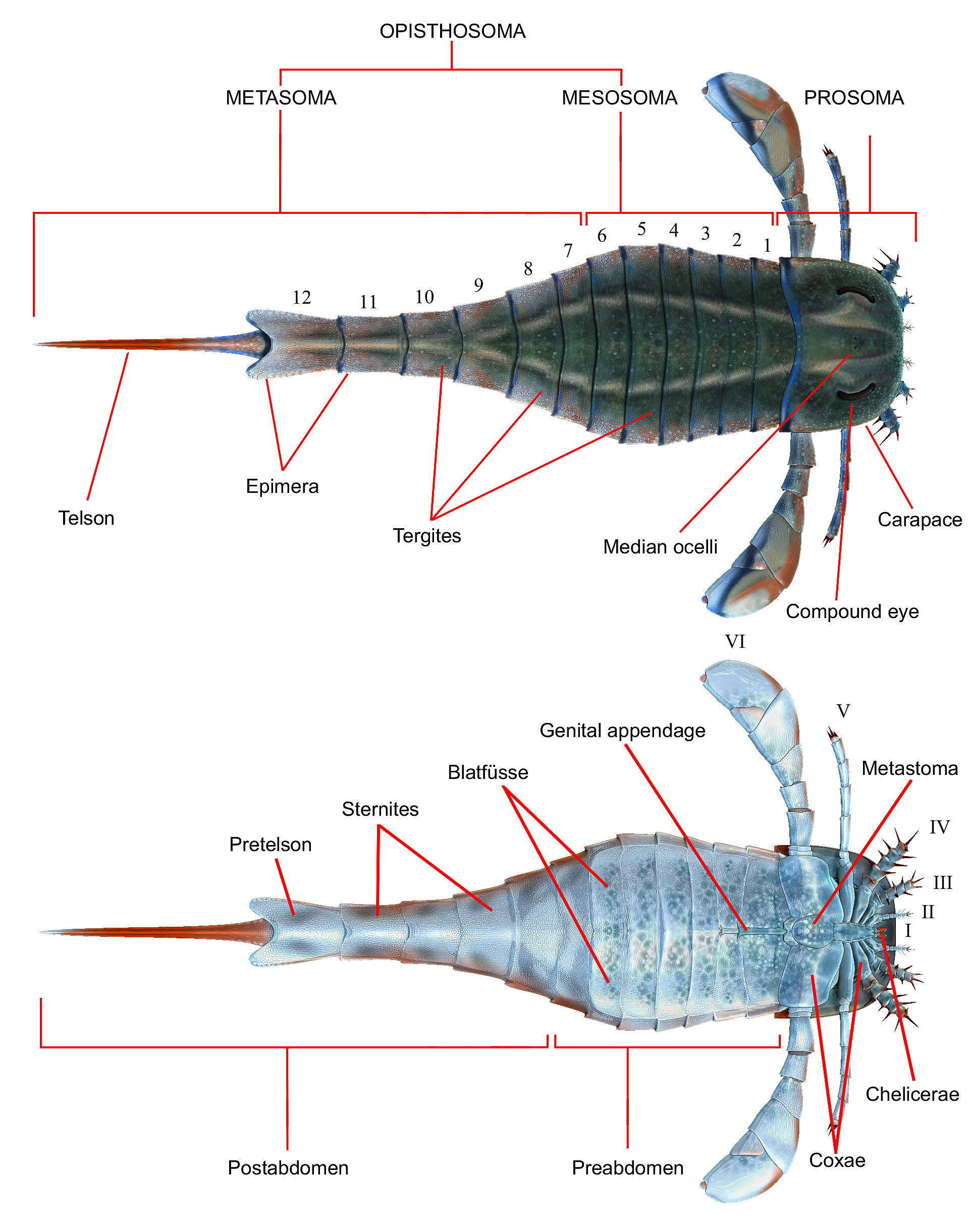|
Pentlandopterus
''Pentlandopterus'' is a genus of prehistoric eurypterid from the Late Ordovician period. The genus contains one species, ''P. minor'', known from the Pentland Hills in Scotland. Classified as part of the Eurypteroidea superfamily, it has not yet been possible to classify it as part of any particular family.Dunlop, J. A., Penney, D. & Jekel, D. 2015. A summary list of fossil spiders and their relatives. In World Spider Catalog. Natural History Museum Bern, online at http://wsc.nmbe.ch, version 16.0 http://www.wsc.nmbe.ch/resources/fossils/Fossils16.0.pdf (PDF). See also * List of eurypterids This list of eurypterid genera is a comprehensive listing of all genera that have ever been included in the order Eurypterida, excluding purely vernacular terms. The list includes all commonly accepted genera, but also genera that are now conside ... References Eurypteroidea Ordovician eurypterids Ordovician arthropods Fossil taxa described in 2013 Fossils of Scotland Eurypt ... [...More Info...] [...Related Items...] OR: [Wikipedia] [Google] [Baidu] |
Eurypteroidea
Eurypteroidea are an extinct superfamily of eurypterids. It contains three families (Dolichopteridae, Eurypteridae, Strobilopteridae) and two genera of uncertain classification, ''Paraeurypterus'' and ''Pentlandopterus''. Description Eurypteroidea, which lived from the Ordovician to Devonian periods, were characterized by their last pair of prosomal (head) appendages, which were developed as swimming legs, carrying paddles formed by the expansion of the two penultimate joints. 1955. Merostomata. ''Treatise on Invertebrate Paleontology, Part P Arthropoda 2, Chelicerata'', P30. as Eurypteracea Families *Order Eurypterida Burmeister, 1843 **Suborder Eurypterina Burmeister, 1845 ***Superfamily Eurypteroidea Burmeister, 1845 ****Genus ''Paraeurypterus'' Lamsdell, Hoşgör & Selden, 2013 ****Genus ''Pentlandopterus'' Lamsdell, Hoşgör & Selden, 2013 ****Family Dolichopteridae Dolichopteridae is an extinct family of eurypterids that lived in the Silurian and Devonian periods. De ... [...More Info...] [...Related Items...] OR: [Wikipedia] [Google] [Baidu] |
List Of Eurypterids
This list of eurypterid genera is a comprehensive listing of all genera that have ever been included in the order Eurypterida, excluding purely vernacular terms. The list includes all commonly accepted genera, but also genera that are now considered invalid, doubtful (''nomen dubium''), or were not formally published (''nomen nudum''), as well as junior synonyms of more established names and genera that are no longer considered eurypterids. The list currently includes 115 names out of which 74 are considered valid eurypterid genera. There are approximately 250 species of eurypterids recognized as valid. Naming conventions and terminology There is no "official" or "canonical" list of eurypterid genera. The closest thing is found contained in the regularly updated ''Summary list'' ''of fossil spiders and their relatives'' in the World Spider Catalog. The vast majority of the content of the list below, including the valid genera, preoccupied names, junior synonyms, taxonomical cl ... [...More Info...] [...Related Items...] OR: [Wikipedia] [Google] [Baidu] |
Eurypterid
Eurypterids, often informally called sea scorpions, are a group of extinct arthropods that form the order Eurypterida. The earliest known eurypterids date to the Darriwilian stage of the Ordovician period 467.3 million years ago. The group is likely to have appeared first either during the Early Ordovician or Late Cambrian period. With approximately 250 species, the Eurypterida is the most diverse Paleozoic chelicerate order. Following their appearance during the Ordovician, eurypterids became major components of marine faunas during the Silurian, from which the majority of eurypterid species have been described. The Silurian genus ''Eurypterus'' accounts for more than 90% of all known eurypterid specimens. Though the group continued to diversify during the subsequent Devonian period, the eurypterids were heavily affected by the Late Devonian extinction event. They declined in numbers and diversity until becoming extinct during the Permian–Triassic extinction event (or sometim ... [...More Info...] [...Related Items...] OR: [Wikipedia] [Google] [Baidu] |
Ordovician
The Ordovician ( ) is a geologic period and system, the second of six periods of the Paleozoic Era. The Ordovician spans 41.6 million years from the end of the Cambrian Period million years ago (Mya) to the start of the Silurian Period Mya. The Ordovician, named after the Welsh tribe of the Ordovices, was defined by Charles Lapworth in 1879 to resolve a dispute between followers of Adam Sedgwick and Roderick Murchison, who were placing the same rock beds in North Wales in the Cambrian and Silurian systems, respectively. Lapworth recognized that the fossil fauna in the disputed strata were different from those of either the Cambrian or the Silurian systems, and placed them in a system of their own. The Ordovician received international approval in 1960 (forty years after Lapworth's death), when it was adopted as an official period of the Paleozoic Era by the International Geological Congress. Life continued to flourish during the Ordovician as it did in the earlier C ... [...More Info...] [...Related Items...] OR: [Wikipedia] [Google] [Baidu] |
Pentland Hills
The Pentland Hills are a range of hills southwest of Edinburgh, Scotland. The range is around in length, and runs southwest from Edinburgh towards Biggar and the upper Clydesdale. Etymology The name is first recorded for the farm of Pentland ( 1050, 1200) and probably derives from Brythonic ''pen llan'', head or top end of the church or enclosure. In the late 15th to mid-16th centuries, land transfers refer to Pentlandmure and Pentland – documents that also list adjacent parcels of land with such still-recognisable names as Loganehous, Hilend, Boghall and Mortounhall. 'Muir', in Pentlandmure, describes common grazings where the farm's livestock would be pastured in summer; and gradually the name was linked more specifically with the slopes of the nearby hills (perhaps Allermuir, Woodhouselee or Castlelaw). The name is completely unrelated to the name of the Pentland Firth in the north of Scotland. Timothy Pont mapped the area in the 1590s, and his work appeared in the m ... [...More Info...] [...Related Items...] OR: [Wikipedia] [Google] [Baidu] |
Scotland
Scotland (, ) is a country that is part of the United Kingdom. Covering the northern third of the island of Great Britain, mainland Scotland has a border with England to the southeast and is otherwise surrounded by the Atlantic Ocean to the north and west, the North Sea to the northeast and east, and the Irish Sea to the south. It also contains more than 790 islands, principally in the archipelagos of the Hebrides and the Northern Isles. Most of the population, including the capital Edinburgh, is concentrated in the Central Belt—the plain between the Scottish Highlands and the Southern Uplands—in the Scottish Lowlands. Scotland is divided into 32 administrative subdivisions or local authorities, known as council areas. Glasgow City is the largest council area in terms of population, with Highland being the largest in terms of area. Limited self-governing power, covering matters such as education, social services and roads and transportation, is devolved from the ... [...More Info...] [...Related Items...] OR: [Wikipedia] [Google] [Baidu] |
Ordovician Eurypterids
The Ordovician ( ) is a geologic period and system, the second of six periods of the Paleozoic Era. The Ordovician spans 41.6 million years from the end of the Cambrian Period million years ago (Mya) to the start of the Silurian Period Mya. The Ordovician, named after the Welsh tribe of the Ordovices, was defined by Charles Lapworth in 1879 to resolve a dispute between followers of Adam Sedgwick and Roderick Murchison, who were placing the same rock beds in North Wales in the Cambrian and Silurian systems, respectively. Lapworth recognized that the fossil fauna in the disputed strata were different from those of either the Cambrian or the Silurian systems, and placed them in a system of their own. The Ordovician received international approval in 1960 (forty years after Lapworth's death), when it was adopted as an official period of the Paleozoic Era by the International Geological Congress. Life continued to flourish during the Ordovician as it did in the earlier Cambrian Per ... [...More Info...] [...Related Items...] OR: [Wikipedia] [Google] [Baidu] |
Fossil Taxa Described In 2013
A fossil (from Classical Latin , ) is any preserved remains, impression, or trace of any once-living thing from a past geological age. Examples include bones, shells, exoskeletons, stone imprints of animals or microbes, objects preserved in amber, hair, petrified wood and DNA remnants. The totality of fossils is known as the ''fossil record''. Paleontology is the study of fossils: their age, method of formation, and evolutionary significance. Specimens are usually considered to be fossils if they are over 10,000 years old. The oldest fossils are around 3.48 billion years old to 4.1 billion years old. Early edition, published online before print. The observation in the 19th century that certain fossils were associated with certain rock strata led to the recognition of a geological timescale and the relative ages of different fossils. The development of radiometric dating techniques in the early 20th century allowed scientists to quantitatively measure the absol ... [...More Info...] [...Related Items...] OR: [Wikipedia] [Google] [Baidu] |
Fossils Of Scotland
A fossil (from Classical Latin , ) is any preserved remains, impression, or trace of any once-living thing from a past geological age. Examples include bones, shells, exoskeletons, stone imprints of animals or microbes, objects preserved in amber, hair, petrified wood and DNA remnants. The totality of fossils is known as the ''fossil record''. Paleontology is the study of fossils: their age, method of formation, and evolutionary significance. Specimens are usually considered to be fossils if they are over 10,000 years old. The oldest fossils are around 3.48 billion years old to 4.1 billion years old. Early edition, published online before print. The observation in the 19th century that certain fossils were associated with certain rock strata led to the recognition of a geological timescale and the relative ages of different fossils. The development of radiometric dating techniques in the early 20th century allowed scientists to quantitatively measure the absolute ... [...More Info...] [...Related Items...] OR: [Wikipedia] [Google] [Baidu] |


.jpg)

